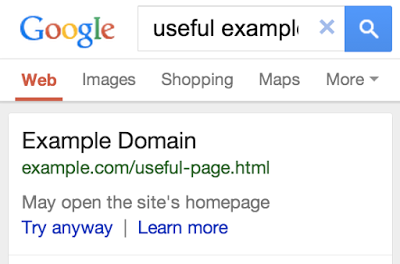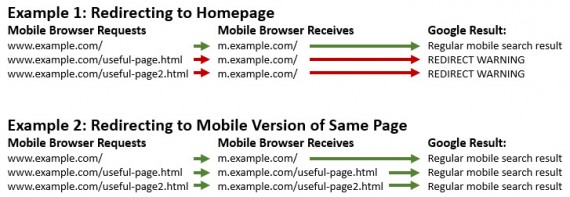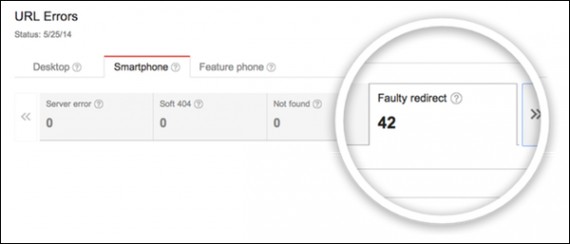In its ongoing crusade to deliver the most beneficial search results, Google announced this week that it will warn searchers when a mobile URL redirects to the home page. Will the change impact your organic search traffic and sales?
How Google’s Faulty Redirect Warning Works
When searchers choose a search result, they expect to receive the content described in that search result. The title in the blue link describes a product or piece of information they want, and ideally the URL and description displayed do as well. However, some sites are set up to redirect mobile browsers to the home page of the site or the mobile site, rather than serve the page that the user expected to land on. Google calls this a “faulty redirect.”
This experience is frustrating to searchers, and Google has taken it upon itself to improve that experience. The image below shows what the warning will look like.

An example of Google’s Faulty Redirect warning in mobile search results.
Instead of the standard description of the page displaying below the URL, a message states “May open the site’s homepage.” Whether most searchers will understand what this warning means to them in practice is dubious, but the “Try anyway” link below it certainly casts an air of doubt on the search result.
We can expect that search results bearing this warning will experience lower click-through rates, resulting in fewer organic visits and sales.
To be clear, the warning is specific to sites that redirect mobile browsers to the home page of their desktop or mobile site when the mobile browser requests any page on the site. The warning does not apply to sites that redirect mobile browsers requesting a desktop URL to that same page on the mobile site, as in example number two below.

Examples of redirecting URLs and the search results they trigger.
How to Tell if Your Site Has Faulty Redirects
Your first instinct will be to search Google from your phone to see if your site is affected. While not definitive, this is a good first step. Try a variety of specific product + site search phrases to prompt Google to return deeper pages of your site. For example, searching for “Target gray tablecloth” would return search results that contain product and category pages rather than Target’s homepage.
The information in Google Webmaster Tools will be more definitive, however. Google will send a message to your Webmaster Tools account if it detects these faulty redirects for mobile browsers on your site. You can also check the Smartphone URL Errors report located in the Crawl Errors section of the Crawl menu. Click the “Smartphone” tab, and you’ll see a new Faulty Redirect tab if this issue applies to your site.

Faulty redirect errors report in Google Webmaster Tools.
How to Escape the Faulty Redirect Warning
Serving mobile visitors with a responsive site, as opposed to a separate mobile version of your site, is the surest way to avoid the mobile redirect warning. Because responsive sites adjust the same page of content at the same URL to accommodate all screen sizes and browser types, there are no mobile redirects to worry about.
If you don’t already have a responsive site and are not planning to build one, it’s unlikely you’ll consider a redesign project of this scale to remove Google’s mobile redirect warnings.
The other option still requires development work, but on a smaller scale. Using the URLs provided as faulty redirects in Google Webmaster Tools, identify the source of the issue in your server configuration. Change that server configuration to redirect mobile searches to the equivalent URL on your mobile site.
In some cases you won’t have a mobile version of every desktop page. In those instances, serve the desktop version of the page rather than redirecting the visitor to the home page. The user experience will still be suboptimal because mobile searchers will have to zoom and pinch and scroll to view the content on the page, but at least they’ll get the content they wanted instead of bouncing out of your home page in confusion.





